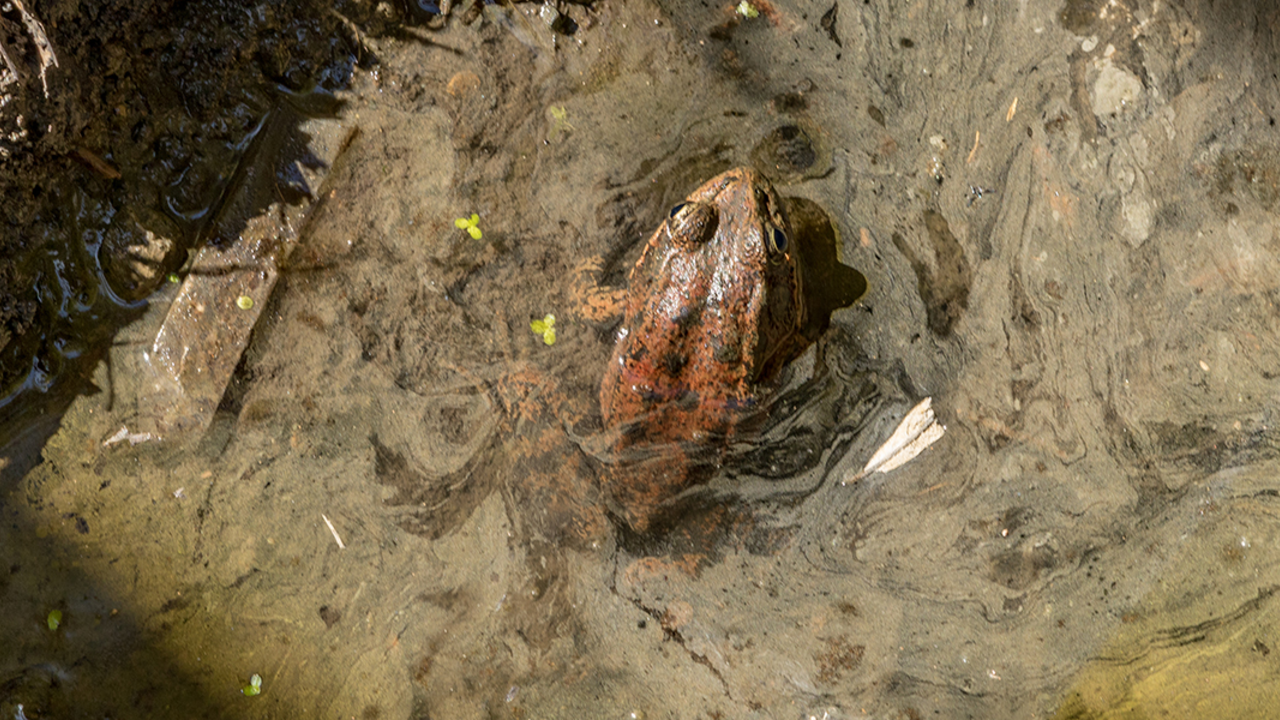California Red Legged Frog
(Rana draytonii)

Kirke Wrench/National Park Service
Threatened or Endangered
California red-legged frogs (Rana draytonii) are federally listed as threatened under the Endangered Species Act.
Population
In the past, over 80,000 red-legged frogs were harvested annually for their legs. Currently, while exact numbers are unknown, only three localities are known to support substantial (over 350) populations of adult frogs.
Description
The abdomen and hind legs of adults are red; the backs are characterized by small black flecks and larger irregular dark blotches with indistinct outlines on a brown, gray, olive, or reddish background color. Dorsal spots usually have light centers. Skin folds across the back are common. In their tadpole stage, the frogs are dark brown and yellow with darker spots.
Size
With some individuals growing to be over 5 inches long, the California red-legged frog is one of the West’s largest native frogs. Females grow larger than males. The larvae range from .6 to 3.1 inches.
Habitat
Adult frogs require dense, shrubby or emergent riparian vegetation closely associated with deep still- or slow-moving waters. During winter, well-vegetated areas along these river corridors are needed for shelter.
Range
Remaining populations of the red-legged frog are found mostly in three California counties: Monterey, Santa Barbara, and San Luis Obispo. The frog’s historical range extended from the vicinity of Point Reyes National Seashore, Marin County, California, coastally, and from the vicinity of Redding, Shasta County, California, inland south to northwestern Baja California, Mexico.
Life Cycle
Eggs are laid, which hatch in 6 to 14 days. Larvae (tadpoles) undergo metamorphosis in 3.5 to 7 months. Sexual maturity is attained at around 3 to 4 years of age. California red-legged frogs may live 8 to 10 years.
Food Source
The diet of California red-legged frogs is extremely variable. Invertebrates, small tree frogs and mammals are eaten by adults, while larvae are thought to feed on algae.
Voice
California red-legged frogs have paired vocal sacks, and usually call into the air.
Behavior
In general, adult frogs are quite wary. Highly nocturnal, they come under attack from wading birds. Adult frogs seem to use vibrations transmitted along the vegetation on which they are sitting to detect the approach of certain other predators, such as raccoons. They also sometimes fall prey to San Francisco garter snakes and two-striped garter snakes, with which they share certain habitat. During periods of flooding, California red-legged frogs have been observed concealed in small pockets or mammal burrows along river banks, stabilized by shrubby riparian growth.
Reproduction
California red-legged frogs breed early in the year, from late November to late April. Males appear at breeding sites typically 2-4 weeks ahead of females, and call in small mobile groups of between 3 and 7 to attract females. Egg masses containing an average of 2,000 small (.1 inches in diameter), dark, reddish-brown eggs are attached to vegetation in or near the water, such as bulrushes or cattails.
Legal Protection
Endangered Species Act; Species of special concern in the state of California. California also reaffirmed its commitment to protect the California red-legged frog by designating it as the official state amphibian in 2014.
Our Work
The Golden Gate National Parks Conservancy has worked to restore wetland habitat at Milagra Ridge and Mori Point in San Mateo County. The Conservancy’s Park Stewardship Program monitors California red-legged frog egg masses at ponds across both sites to confirm frog presence or absence and to understand trends in the winter-breeding frog population. In addition, California red-legged frogs were reintroduced to the the lower Redwood Creek Watershed in 2010-2011, where monitoring indicates that they are benefitting from the Conservancy’s extensive, ongoing restoration work.